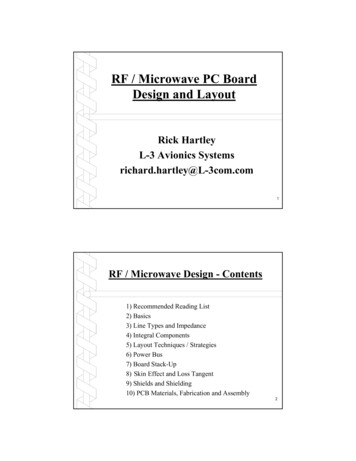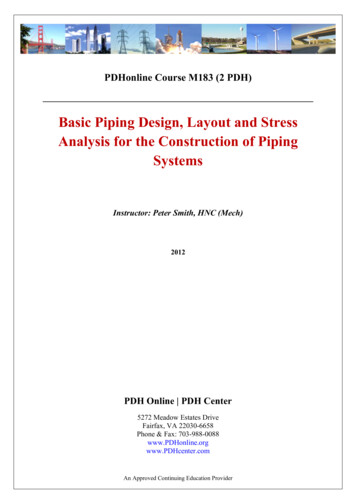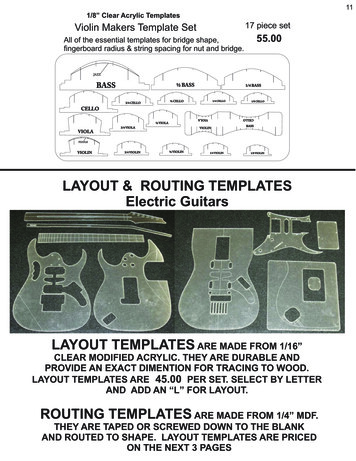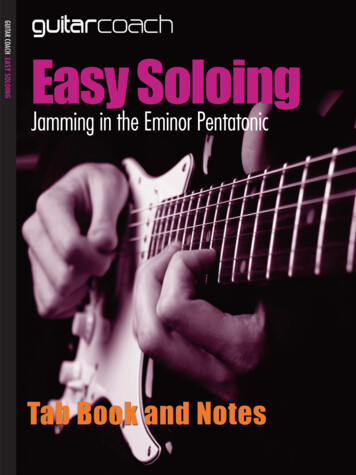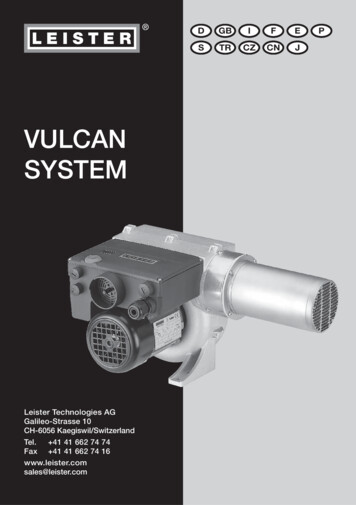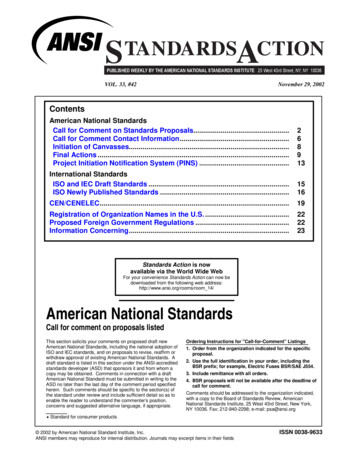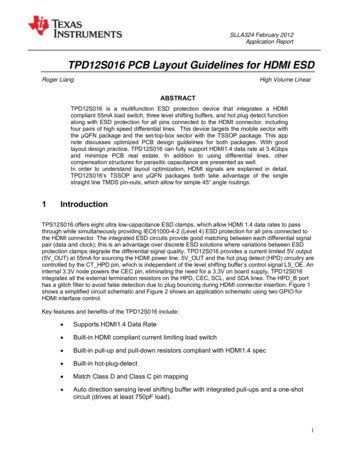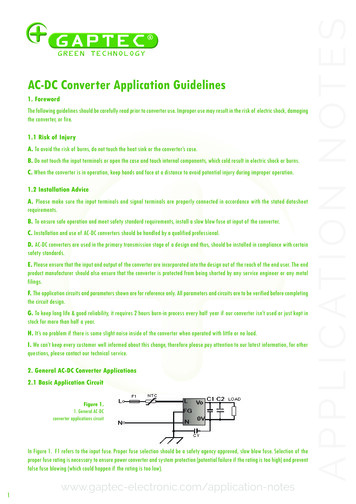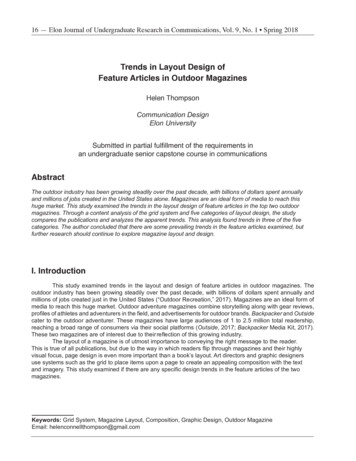
Transcription
16 — Elon Journal of Undergraduate Research in Communications, Vol. 9, No. 1 Spring 2018Trends in Layout Design ofFeature Articles in Outdoor MagazinesHelen ThompsonCommunication DesignElon UniversitySubmitted in partial fulfillment of the requirements inan undergraduate senior capstone course in communicationsAbstractThe outdoor industry has been growing steadily over the past decade, with billions of dollars spent annuallyand millions of jobs created in the United States alone. Magazines are an ideal form of media to reach thishuge market. This study examined the trends in the layout design of feature articles in the top two outdoormagazines. Through a content analysis of the grid system and five categories of layout design, the studycompares the publications and analyzes the apparent trends. This analysis found trends in three of the fivecategories. The author concluded that there are some prevailing trends in the feature articles examined, butfurther research should continue to explore magazine layout and design.I. IntroductionThis study examined trends in the layout and design of feature articles in outdoor magazines. Theoutdoor industry has been growing steadily over the past decade, with billions of dollars spent annually andmillions of jobs created just in the United States (“Outdoor Recreation,” 2017). Magazines are an ideal form ofmedia to reach this huge market. Outdoor adventure magazines combine storytelling along with gear reviews,profiles of athletes and adventurers in the field, and advertisements for outdoor brands. Backpacker and Outsidecater to the outdoor adventurer. These magazines have large audiences of 1 to 2.5 million total readership,reaching a broad range of consumers via their social platforms (Outside, 2017; Backpacker Media Kit, 2017).These two magazines are of interest due to their reflection of this growing industry.The layout of a magazine is of utmost importance to conveying the right message to the reader.This is true of all publications, but due to the way in which readers flip through magazines and their highlyvisual focus, page design is even more important than a book’s layout. Art directors and graphic designersuse systems such as the grid to place items upon a page to create an appealing composition with the textand imagery. This study examined if there are any specific design trends in the feature articles of the twomagazines.Keywords: Grid System, Magazine Layout, Composition, Graphic Design, Outdoor MagazineEmail: helenconnellthompson@gmail.com
Trends in Layout Design of Feature Articles in Outdoor Magazines by Helen Thompson — 17II. Literature ReviewThis literature review will explain the history, purpose, and use of the grid system. This system wasused as the basis for the research in this study; therefore, it is important to understand its origins and usesHistory of the Grid SystemThe grid system has been in place for many years, although it has not always been used so overtlyor called by that name. Design of printed publications began in the early stages of book creation whenmanuscripts were hand lettered by scribes. A huge shift in mindset and abilities arrived with the inventionof movable type. From the invention of the printing press to the Industrial Revolution, books were themain printed publication and almost all used what we would call a “manuscript” layout today. This was asingular column of text that was positioned on the page according to geometrical principles that determinedsymmetrical margins, gutters and header spacing (Samara, 2002). Various forms of design created artisticmovements, which built upon each other to create the graphic design and typographic principles we havetoday.The Arts and Crafts movement, led by William Morris, was key to linking form and function within thedesign of pages (Samara, 2002). Many twentieth-century artistic movements influenced the creation of thegrid as we know it today in an unconventional way. These artistic movements broke many of the previoustraditions regarding text and experimented with abstract composition and typographic interpretations (Roberts,2008). These untraditional and chaotic artistic movements paved the way for new movements that createdstructure and set the basis for the grid system we know today. Major design and art schools in Europe,such as the Bauhaus and the De Stijl movement, called for minimalism and relied heavily on geometry. JanTschichold brought these art concepts to mainstream printers. He advocated for the Bauhaus idea of structureand began using similar vertical and horizontal alignments to structure his designs. Tschichold shared theseideas in his popular typography books. Along with various other German designers, Tschichold was exiled toSwitzerland during World War II (Samara, 2002). Swiss designers had a large impact on typography and theinstallation of the grid system in graphic design (Roberts, 2008). A Swiss student of design, Karl Gerstner,took the grid design further than before to create an almost mathematically perfect grid for his journal, Capital(Ambrose & Harris, 2015). The grid uses small enough measurements that can build greater modules whilestill maintaining equal spacing (Ambrose & Harris, 2008). Since the 1960s, the grid has been a staple increating cohesive corporate communication design (Samara, 2002).Explaining the Grid SystemThe grid system that we know today can be adapted for many uses of layout design. The grid is a toolto support designers in their decision making for creating interesting and visually appealing designs (Ambrose& Harris, 2015). Grids function as a behind-the-scenes structure for designers to achieve consistency,balance, and coherency throughout publications. Various elements in the grid system are important tounderstand how it is used.The gridlines can be used to create a variety of standard layouts that designers can manipulate to fittheir needs. Grids are created based on the absolute and relative measurements of the page to be designed.Absolute measurements are typically in inches or points and are of fixed values (Ambrose & Harris 2008).Relative measurements are created relative to each individual grid layout. Grids for every layout should becreated with the knowledge of what elements (images, text, headlines, etc.) will be included and what theformat of the publication should be (paper size, binding, etc.).The grid system is incredibly useful for creating cohesive designs, especially when working withmultiple spreads. There are many components of design and the grid system that must be understood beforean analysis of designs can be done. For a basic understanding of terms, refer to Appendix A and B.Magazine Use of the GridThe main types of grids in magazine layouts are the column grid, the module grid, and a compoundgrid, which combines the former two types (Ambrose & Harris, 2008). These types of layouts give optimalallowance for manipulating text and graphic elements. The column grid can be adapted to various amounts ofcopy in order to display a certain context. In magazines, the standard layout is often a three-column design.
18 — Elon Journal of Undergraduate Research in Communications, Vol. 9, No. 1 Spring 2018For more in-depth features, two columns can be used to display both images and text easily, or longeramounts of copy (Samara, 2017).When setting columns on the page it is important to consider the margins and gutters. Beyond thecolumn, some grids utilize the horizontal guidelines, called flowlines, which can break up the page across thecolumn grid to create a module grid.A module is a unit of space formed by both horizontal and vertical gridlines that are used to housetext, image or graphics. A module grid is the structure of gridlines upon which these modules exist. Individualmodules can also be combined to create larger blocks and a sense of movement within the page. The mixtureof both modules and columns in a grid creates a compound grid (Ambrose & Harris, 200). This is arguably themost versatile grid type, as it allows for less strict guidelines. The compound grid is a grid that mixes modulesand columns, or two grid structures at once (Samara, 2017). The compound grid gives designers the mostamount of flexibility of all the grid types.The symmetry of the margins can create a uniform feel to a spread, where an asymmetrical spreadcould indicate movement and subtly encourage the reader to turn the page. A symmetrical grid is one in whichthe margins within the spread mirror each other. An asymmetrical grid is one in which the left and right pageof a spread have the exact same margins, usually offset to the left or right (Ambrose & Harris, 2008). Whenworking with a symmetrical column grid it is easy to create simplistic and boring compositions. However, thesecan be enhanced through the placement of other elements on the page such as images, enlarged text boxes,or graphics.Image placement can have a great impact on the visual aesthetic of a layout. When using largeformat pictures that take up the whole page, there are two different types of placement. The first would befull bleed, which is an image that takes up the entire page, including the margins (Ambrose & Harris, 2008).An image that was “passepartout” would have borders or white space surrounding the outer edge of a pageor image (Ambrose & Harris, 2015). The major difference between these two compositions is the image’srelationship to the edge of the page, which is known as the perimeter. If a layout has an active perimeter,some of the design elements – usually images – occupy the page edge. If the layout has a passive perimeter,the design elements have a distance from the page edge (Ambrose & Harris, 2008).Besides images, the most important component of a layout is the utilized text. For a magazine article,there are multiple types of text to consider. All articles will have body copy, a headline, and a byline. Many willhave a subheading as well and captions for any images. A hierarchy is a logical and visual way to expressthe relative importance of different elements by way of scale or placement. When designing for a magazinearticle, it is important to consider the hierarchy of text, especially on the first page or spread which servesas the title page for the article. Text can be presented in many ways; at an angle, vertically, horizontally orbroadside. Broadside text is created by rotating text 90 degrees to the spine so that it reads vertically. Thecomposition of a layout can be dramatically altered by text placement, so these elements of design areimportant to consider. Lastly, when working with text, alignment is important. Within the columns or text boxesof an article, text can be aligned vertically and horizontally. Horizontal alignment is the lining up of text in afield on the horizontal page, it can be aligned center, range right, range left or justified. Vertical alignment iswhere text is placed within the vertical plane of a field, which can be at the top, bottom, center, or justified(Ambrose & Harris, 2008).Lastly, there are a few items in the margins and gutters of every magazine spread. The folios are thepage numbers. Their placement can draw the reader’s eye across the page and have a dramatic impact onthe overall design for such a small item (Ambrose & Harris, 2008). Running headers are text at the top of thepage that stays consistent throughout the layout but can be aligned symmetrically or asymmetrically, similarto folios (Ambrose & Harris, 2015).These small elements may seem insignificant, but they should not beoverlooked since they can greatly influence how the reader views a layout at first glance.In this paper, these main design elements were examined within the context of feature articles in anoutdoor magazine. The five categories of types of grids, symmetry, image placement, text placement andmiscellaneous were explored.
Trends in Layout Design of Feature Articles in Outdoor Magazines by Helen Thompson — 19III. MethodsContent analysis was chosen as the best method of research. To determine the top two magazinesfor the outdoor industry, the author examined social media following, and magazine rate base, and theaverage circulation level of the magazine (“Rate Base,” 2017). The top two magazines chosen wereBackpacker and Outside. Each magazine published a minimum of nine issues per year. The author chosean issue from each of the four seasons for each magazine in 2017. This resulted in four issues per magazinewith a range of topics for each season. Once the magazines were selected, the author chose to examine thefirst feature article in each. Feature articles were defined as articles that focus on an event or individual with ahumanistic perspective. They did not include any product features, nor any article that displays only lists.The author raised the research question: How do the two magazines selected utilize the following fivedesign categories in the composition and layout design of their feature articles?The articles were analyzed for each of these five major categories. The author counted theappearances of each design principle or grid element. These counts were compared to the total number ofpages to calculate its relative occurrence.The author analyzed the following five design categories that were embodied by the two magazines: The Type of Grid: Of the three types of grids, column, module or compound, which was used themost? Symmetry: Did the composition, specifically the margins and columns of each spread, mirror eachother to create symmetry? Image Placement: Were the images placed on the page with an active perimeter, passiveperimeter, or passepartout? How many full bleed images were used? Typography: Was there consistency between the types of fonts used in each article? Was ahierarchy of text present in the titles? Were there any appearances of broadside text? Miscellaneous: What was the placement of folios and running headers?IV. Findings
02.05.2018 · Art directors and graphic designers use systems such as the grid to place items upon a page to create an appealing composition with the text and imagery. This study examined if there are any specific design trends in the feature articles of the two magazines. Trends in Layout Design of Feature Articles in Outdoor Magazines by Helen Thompson — 17 II. Literature Review This literature review .
